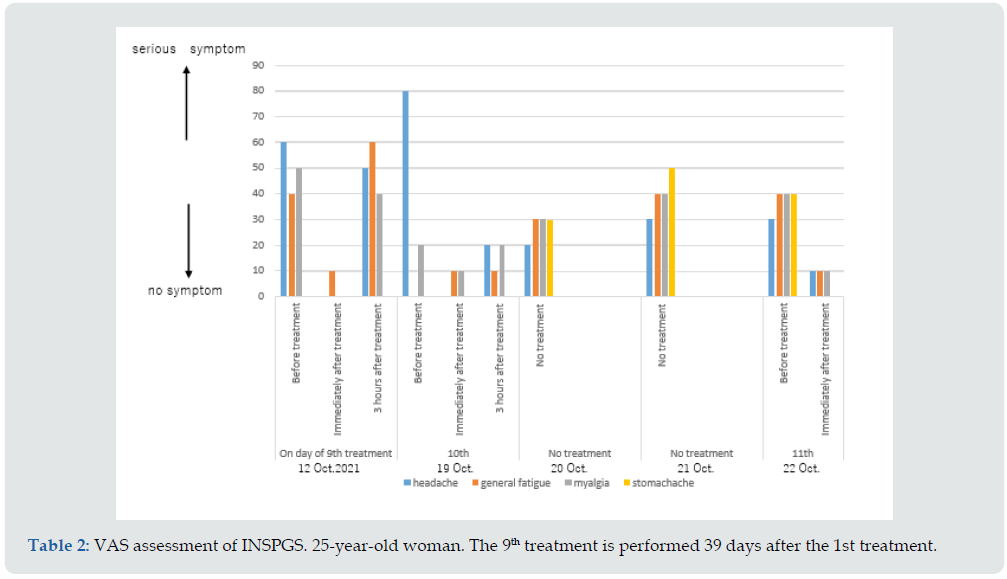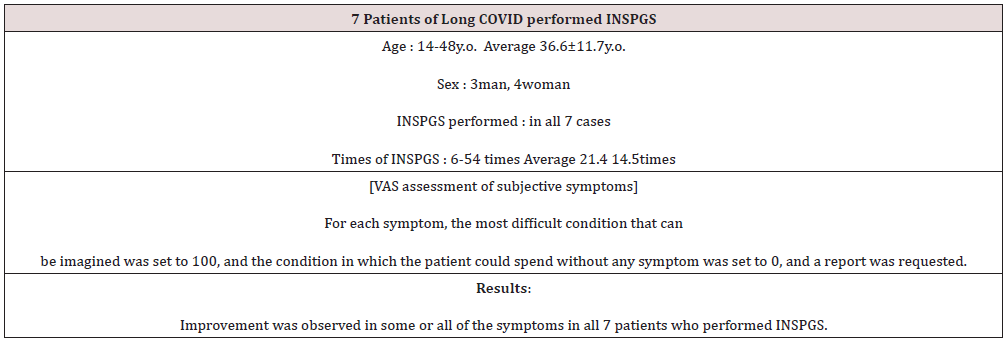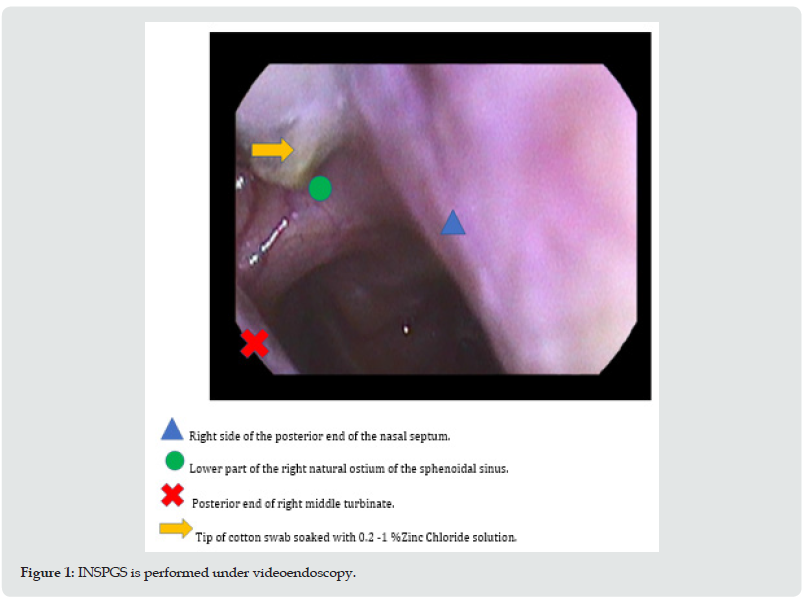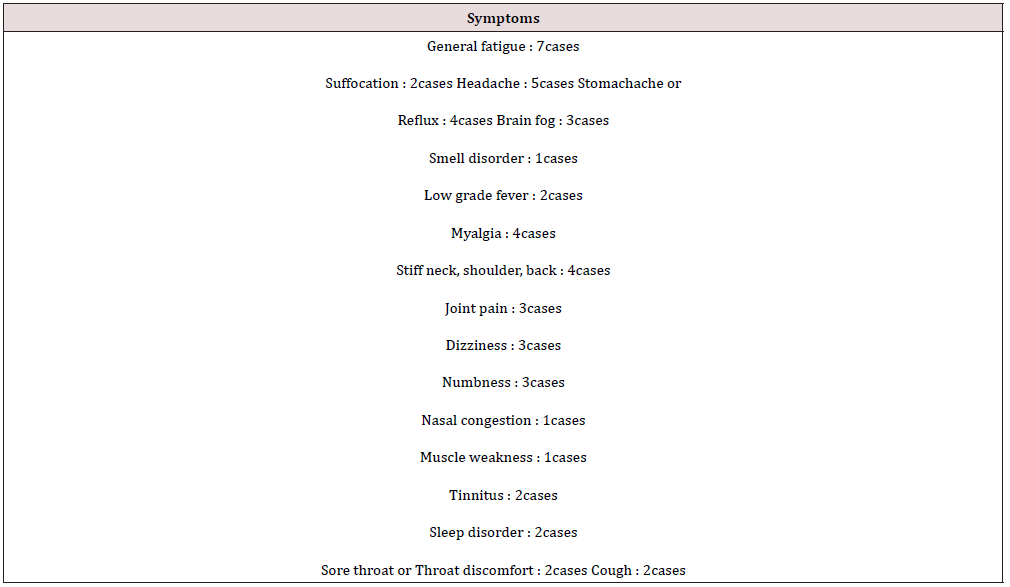
Lupine Publishers Group
Lupine Publishers
Menu
ISSN: 2641-1709
Research Article(ISSN: 2641-1709) 
The efficacy of Intranasal Sphenopalatine Ganglion Stimulation (INSPGS) in Long COVID, and its Possible Mechanisms Volume 8 - Issue 2
Ayaki Tanaka*1,2 and Osamu Hotta2,3
- 1Department of ENT, Tanaka ENT Clinic, Japan
- 2Japanese Focal Inflammation related Disease Research group, Japan
- 3Department of Internal Medicine, Hotta Osamu Clinic, Japan
Received: April 13, 2022; Published: April 21, 2022
Corresponding author: Ayaki Tanaka, Department of ENT, Tanaka ENT Clinic, Osaka, Japan
DOI: 10.32474/SJO.2022.08.000283
Abstract
Intranasal Sphenopalatine ganglion stimulation (INSPGS), which mechanically stimulates the sphenopalatine ganglion with a cotton swab from the nose, was performed in 7 cases of Long COVID (LC). In the evaluation report by Visual Analogue Scale, improvements were recognized in all or part of the symptoms in all 7 cases. INSPGS might be effective as a treatment for LC, and its possible mechanisms might be similar to SPG electrical stimulation, i.e., that of cerebrovascular collateral vasodilation, stabilization of blood-brain barrier, direct neuroprotection, and enhanced brain plasticity. The mechanical Sphenopalatine ganglion (SPG) stimulation by INSPGS might physiologically block the parasympathetic efferent, therefore turning off the efferent pathway of the trigeminal-autonomic reflex. INSPGS is a simple procedure, and it is one of the advantages that clinical application is easy.
Keywords: Intranasal sphenopalatine ganglion stimulation (INSPGS); Long COVID; SPG stimulation; trigeminal autonomic cephalalgias (TACs)
Introduction
After SARS-CoV-2 infection, it is known that various symptoms that last for several months or more persist as sequelae even after the virus is no longer detected by PCR, these are known as Long COVID (LC), Long-haul COVID, Post-COVID syndrome, Post-acute sequelae of SARS-CoV-2 infection (PASC). Symptoms are serious general fatigue, diminished ability to think, brain fog, depression, anxiety, headache, myalgia, joint pain, chest pain, neck / back pain, suffocation, palpitation, shortness of breath, hair loss, smell disorder, taste disorders, dizziness, tinnitus, stomachache, gastric acid reflux, sore throat, cough, nasal obstruction, low grade fever, sleep disorders, etc. COVID-19 Pneumonia is a typical pathological condition in the acute phase, and there are sequelae accompanied by organic changes such as fibrosis of lung tissue after pneumonia. However, there are many cases without organic findings found in LC. At our clinic (Tanaka ENT Clinic), we performed intranasal sphenopalatine ganglion stimulation (INSPGS) in 7 cases of LC, and all of them noticed improvement in all or part of the symptoms. The treatment experience and the possible mechanisms of INSPGS in LC are outlined.
Methods
We examined the efficacy of INSPGS in 7 patients with LC who underwent INSPGS at our facility from April to October 28, 2021 and submitted a self-assessment report by Visual Analogue Scales (VAS) by October 28. Of the seven cases, there were three men and four women. The age distribution was 14 to 48 years old, and the mean and standard deviations were 36.6 ± 11.7y.o. The number of INSPGS enforced was 6 to 54 times, and the average number of times was 21.4 ±14.5 times. At the first treatment, the lower part of the natural ostium of sphenoidal sinus between the middle nasal turbinate and the nasal septum, where is the innervated area of the sphenopalatine ganglion, was confirmed under the intranasal video endoscope (Figure 1). INSPGS was performed under video endoscope at the first treatment via both nasal cavities. Insert a thin cotton swab soaked with 0.2-1% zinc chloride solution that has astringent and anti-inflammatory effects into the niche between the middle turbinate and the nasal septum. After touching the bone in front of the sphenoidal sinus, which is the innervated area of the sphenopalatine ganglion, gently tap the cotton swab 5 times and keep it in place for 30 seconds. Thereby, SPG is mechanically stimulated by INSPGS (Figure 2). In principle, INSPGS was performed once a week. It was dependent on the individuals to decide whether to take the other therapy includes oral medicines at other facilities or not. And in general, only INSPGS was performed at our clinic (Tables 1 & 2).
Table 2: VAS assessment of INSPGS. 25-year-old woman. The 9th treatment is performed 39 days after the 1st treatment.

Figure 2: Insert a thin cotton swab soaked with 0.2-1% Zinc Chloride solution that has astringent and anti-inflammatory effects into the niche between the middle turbinate and the nasal septum. After touching the bone in front of the sphenoidal sinus, which is the innervated area of the sphenopalatine ganglion, gently tap the cotton swab 5 times and keep it in place for 30 seconds. Thereby, SPG is mechanically stimulated by INSPGS.

Results
In all 7 cases, VAS evaluation showed that some or all symptoms were improved. A representative course of LC patient treated with INSPGS is shown in Table 3. The first visit to our department was conducted on September 4th, 2021, and the 9th INSPGS were performed as of October 12th, 39 days after the 1st treatment. Immediately after the treatment, headache, and myalgia disappeared on October 12th, and each symptom gradually recurred 3 hours after the treatment. At the time of the 10th treatment on October 19th, headache before the treatment was about 80 in VAS, but disappeared immediately after the treatment (0 in VAS) and returned to about 20 in VAS 3 hours after the treatment. No treatment was given on October 20th and October 21st, and the 11th treatment was given on October 22nd, but the symptom that was 30-40 in VAS before the treatment improved to about 0-10 immediately after the treatment (Table 2). In LC, as in this case, there are some cases in which the symptoms gradually improve while repeating remission and exacerbation of each symptom by INSPGS. However, even in cases whose general fatigue and myalgia are improved by treatment such as INSPGS, or oral medication at another hospital, PEM (Post Exertional Malaise) may occur, and careful treatment is required.
Discussion and Possible Mechanisms of INSPGS
The sphenopalatine ganglion (SPG) is a ganglion consisting of branches from the second branch of the trigeminal nerve, and sphenopalatine ganglion pain is derived from the report by Sluder [1] , so it is called Sluder neuralgia. Sluder neuralgia causes referred pain in the base of the nose, around the eyes, maxilla, mandible, teeth, cheeks, ears, neck and shoulders. In the International Classification of Headache Disorders [2], both cluster headache and Sluder neuralgia are classified into TACs (headache with trigeminal autonomic symptoms). The same classification describes that the trigeminal nerve and the trigeminal neurovascular system are also involved in migraine, which had been conventionally considered to be a disorder of the vascular system [2]. Schoenen reports that SPG electrical stimulation by implanting an electrical device is effective for cluster headache [3], also describe important views as below.
a) Cardinal features of Cluster Headache attacks are the prominent autonomic symptoms.
b) Increased cranial parasympathetic outflow activate trigeminal afferents via the trigeminovascular system.
c) Electrical stimulation of the SPG may physiologically block the parasympathetic efferents, thereby turning off the efferent arm of the trigeminal-autonomic reflex.
d) The stimulation frequency is likely to be important for this effect.
The mechanical SPG stimulation by INSPGS might physiologically block the parasympathetic efferents, therefore turning off the efferent pathway of the trigeminal-autonomic reflex. It might be one of the possible mechanisms of INSPGS’s clinical efficacy on autonomic symptoms including TACs in patients with LC. Khurana reports that SPG electrical stimulation is effective in improving cerebral blood flow in acute ischemic stroke [4]. Bornstein and Saver conducted a randomized controlled trial [5] in which SPG electrical stimulation was started 8 to 24 hours after the onset of acute ischemic stroke and continued for 5 days, and SPG electrical stimulation was reported to be effective for acute ischemic stroke [6]. Four mechanisms are cited as the mechanism of SPG electrical stimulation in acute ischemic stroke as below.
a. Enhancement of collateral circulation,
b. Stabilization of blood-brain barrier,
c. Direct neuroprotection,
d. Enhancement of brain plasticity.
Cheyuo [7] showed how the parasympathetic nerve, especially the vagus nerve, are innervated in the brain, with the vagus nerve afferent tract. Afferent tract of vagus nerve innervates to solitary nucleus, then to superior salivary nucleus, then to sphenopalatine ganglion, finally to anterior, middle, and posterior cerebral arteries and basilar arteries. It was revealed that the postganglionic fibers projected onto these arteries concern Nitric Oxide-dependent cerebral blood flow regulation. INSPGS, which mechanically stimulates SPG via the nose, may be involved in improving cerebral blood flow and exerting its clinical effect by a mechanism of action like the four mechanisms of action of SPG electrical stimulation therapy reported by Saver.
Conclusion
SPG electrical stimulation therapy is also attracting attention as a bioelectronic therapy, but basically it is necessary to implant an electrical device in the body, and the threshold for clinical application might be high. INSPGS is a method of mechanically stimulating the lower part of the natural ostium of the sphenoidal sinus, which is the area innervated by the sphenopalatine ganglion, with a cotton swab soaked with Zinc Chloride solution that has astringent and anti-inflammatory effect. The procedure of INSPGS is quite simple, therefore it is easy for clinicians to incorporate this treatment into clinical practice.
Acknowledgment
Conflict of Interest and Financial Disclosures: The authors have no funding, financial relationship, or conflicts of interest to disclose.
References
- Sluder G (1910) The syndrome of sphenopalatine ganglion New York Med J 140: 868-878.
- (2018) International Classification of Headache Disorders, 3rd Headache Classification Committee of the International Headache Society (HS). Cephalalgia 38(1): 1-211.
- Schoenen J (2013) Stimulation of the sphenopalatine ganglion (SPG) for cluster headache treatment. Pathway CH-1: A randomized sham-controlled study. Cephalalgia 33(10): 816- 830.
- Khurana D (2019) Implant for Augmentation of Cerebral Blood Flow Trial-1 (ImpACT-1). A single-arm feasibility study evaluating the safety and potential benefit of the Ischemic Stroke System for treatment of acute ischemic stroke. PlOS ONE 14(7): e0217472.
- Bornstein NM, Saver JL, Stroke (2019) Sphenopalatine Ganglion Stimulation to Augment Cerebral Blood Flow-A Randomized. Sham-Controlled trial 50: 2108-2117.
- Hosseini MB, Saver JL (2020) Mechanisms of action of acute and subacute sphenopalatine ganglion stimulation for ischemic stroke.. Int J Stroke 15(8): 839-848.
- Cheyuo C (2011) The parasympathetic nervous system in the quest for stroke therapeutics. J Cerebral Blood Flow & Metabolism 31: 1187-1195.

Top Editors
-

Mark E Smith
Bio chemistry
University of Texas Medical Branch, USA -

Lawrence A Presley
Department of Criminal Justice
Liberty University, USA -

Thomas W Miller
Department of Psychiatry
University of Kentucky, USA -

Gjumrakch Aliev
Department of Medicine
Gally International Biomedical Research & Consulting LLC, USA -

Christopher Bryant
Department of Urbanisation and Agricultural
Montreal university, USA -

Robert William Frare
Oral & Maxillofacial Pathology
New York University, USA -

Rudolph Modesto Navari
Gastroenterology and Hepatology
University of Alabama, UK -

Andrew Hague
Department of Medicine
Universities of Bradford, UK -

George Gregory Buttigieg
Maltese College of Obstetrics and Gynaecology, Europe -

Chen-Hsiung Yeh
Oncology
Circulogene Theranostics, England -
.png)
Emilio Bucio-Carrillo
Radiation Chemistry
National University of Mexico, USA -
.jpg)
Casey J Grenier
Analytical Chemistry
Wentworth Institute of Technology, USA -
Hany Atalah
Minimally Invasive Surgery
Mercer University school of Medicine, USA -

Abu-Hussein Muhamad
Pediatric Dentistry
University of Athens , Greece

The annual scholar awards from Lupine Publishers honor a selected number Read More...







